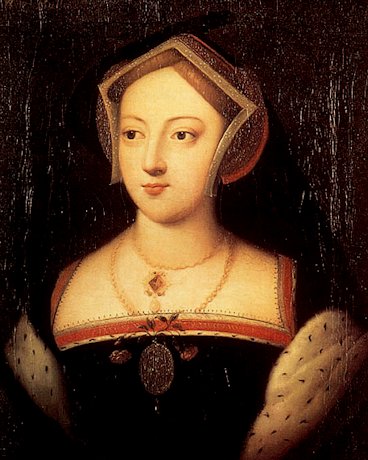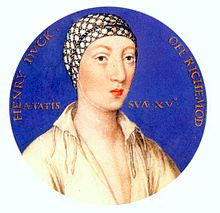
Above: Portrait of an unknown woman, c.1525, possibly of Bessie Blount.
We are obsessed with Henry VIII's women. To date, at least two books (by Kelly Hart and Philippa Jones) have been published about Henry's loves, and numerous books have been published about his infamous six wives, including by respected Tudor historians such as David Starkey, Professor David Loades and the bestselling Alison Weir. Anne Boleyn is the subject of numerous biographies every year, and historians and writers are increasingly turning their attention to the less famous women he was involved with, including Mary Boleyn (following the success of Philippa Gregory's 2001 novel The Other Boleyn Girl), Jane Seymour and Katherine Howard.
Bessie Blount has long been an important name in accounts of Henry VIII's love affairs. We know that he was involved with at least eight women in the course of his fifty-five year life, including his six wives and at least two named mistresses, Mary Boleyn and Bessie herself. But was Bessie the great love of his life, at least during the fading years of his marriage to first wife Katherine of Aragon? She was certainly prominent as the mother of his only acknowledged bastard son Henry Fitzroy (1519-1536). But after her affair with the king Bessie faded into obscurity. We don't know the date of her birth, we don't know the date of her death, and we can't even be sure what she looked like.


Above: Mary Boleyn was probably Henry VIII's mistress for a considerably shorter time than her predecessor Bessie Blount.
Anne Boleyn - Henry's passion for Anne would of course surpass any feelings held for Bessie.
Bessie Blount was probably born by 1500 to Sir John Blount and Katherine Pershall in Shropshire. Her father was a loyal servant to the Tudors, a fact that probably proved of considerable importance in Bessie's career, for his loyalty to the crown perhaps offered an opportunity for his daughter to become a maiden to Katherine of Aragon, consort of Henry VIII. Bessie had arrived at court by 1514, aged about fourteen, and it seems that she had soon caught the eye of the young king. Beverley Murphy, in her article about Bessie published in Oxford Dictionary of National Biography, relates that Bessie had arrived at court by the end of March 1512. Since maidens usually had to be aged a minimum of thirteen years to serve a queen or high-ranking noblewoman, she must have been born by 1499 the latest. Her beauty has often been commented on, but as no surviving portrait exists of Bessie (the portrait at the top of this article may be of her), it is impossible to verify. In 1529, she was confirmed to be more beautiful than Henry's new love, Anne Boleyn. Since Anne's darkness may have served as a reason why she was not considered more attractive, one could surmise from this that Bessie was more conventionally attractive in terms of her appearance; and so might have been blonde or at least fair.
Bessie was particularly renowned for her skill in music and dancing, two social graces that were considered essential to young women at court hoping to attract a prestigious marriage and enhance their family's fortunes. The king danced with the teenage Bessie at the New Year celebrations of 1514. At some point, he took her as his mistress. What their relationship is like is impossible to comment on. Murphy contends that 'the lack of any concurrent references suggests that their... affair was short-lived'. Perhaps, it is time to revise the long-held view, perpetuated in TV, film and historical novels, that Henry VIII enjoyed romantic liaisons with women such as Bessie and Mary Boleyn. Alison Weir, for example, in her 2011 biography of Mary, contends that her relationship with Henry was hardly the true love story depicted in The Other Boleyn Girl. Like Mary, it is possible that Bessie's affair with Henry was brief and of little importance.
In June 1519, Bessie delivered the twenty-eight year old king a bastard son, Henry Fitzroy. He was later created Duke of Richmond and Somerset and Earl of Nottingham, prestigious titles that infuriated the humiliated Queen Katherine of Aragon, who may have perhaps identified him as a threat to her three-year old daughter Princess Mary. There were later rumours, almost certainly false, that the king planned to marry his bastard to his daughter. Certainly Bessie's son proved that Henry could sire sons, and established, in his mind at least, that the fault lay with the queen for his lack of a legitimate male heir.

Above: Henry Fitzroy, bastard son of Henry VIII and Bessie Blount.
By September of that same year Bessie had been married off to Gilbert Tailboys, which Murphy contends was a reward for Bessie because Gilbert was a ward of the crown. Bessie was granted property worth £200 per annum for life and the couple had three children once settled down in Lincolnshire: Elizabeth (born about 1520), George, and Robert. Between 1522 and 1539 Bessie continued to receive grants from the king. Gilbert died in 1530. At this time, of course, Henry was besotted by Anne Boleyn, and so did not consider taking the widowed Bessie as his wife, a move which would have legitimated his son Henry.
Bessie's role in her son's upbringing is uncertain, although records indicate that she made regular gifts to him, including a doublet and two horses in 1531. A letter of hers to his tutor John Palsgrave survives, which perhaps 'suggests that her involvement in the duke's upbringing was greater than has been generally allowed'. (Murphy) By 1535, Bessie had remarried. Her husband was Edward Fiennes de Clinton, who later became first earl of Lincoln. Bessie delivered three more daughters: Bridget, Katherine, and Margaret. However, misfortune struck Bessie in 1536 when her seventeen-year old son Henry Fitzroy died. It was a grievous blow and the king may have been profoundly affected by it, coming as it did two months after Queen Anne's execution. Henry had hinted that he believed his late wife had poisoned both the duke and his daughter Mary.
Bessie later served as lady-in-waiting to Anne of Cleves but ill-health prevented her from serving Anne's successor Katherine Howard. She died sometime between January 1539 and June 1541, aged probably in her early forties. As Karen Lindsey comments, Bessie's relative importance is negligible contrasted with the importance of Katherine of Aragon and Anne Boleyn, but she was certainly more significant than any of Henry's other mistresses including Mary Boleyn, in that she delivered his only known bastard son who was, at once point, perhaps considered by the king as a possible heir to the throne.
What Bessie's personal relationship with the king was like is impossible to say with certainty. Perhaps she enjoyed a romantic relationship with him that lasted several years, or perhaps it was a brief interlude following on the heels of his increasing disillusionment with Katherine of Aragon and occurring shortly before his involvement with the Boleyn women. But the king certainly appears to have valued her, especially since he continued bequeathing her gifts during her later life and allowing her to be involved in her son's upbringing. Bessie certainly enjoyed a more fortunate career than some of Henry's other women, for she married twice, bore several children, enjoyed relative wealth and prosperity, and lived to what would be viewed in the Tudor period as a good age. Fortunately for her, it was not her fate to be discarded, divorced, rejected, or beheaded.
For a long time, I've considered the Royal Ontario Museum miniature by Lucas Hornebolte, and a version of it in the Duke of Buccleuch and Queensberry's collection,
ReplyDeleteto be a portrait of Bessie Blount rather than of Anne Boleyn. The only contemporary image of the latter is a rather worn medal in the British Museum which presents a long
oval face which differs significantly from that in the above miniature portrait. Also, the Hornebolte portrait can be dated to the mid-1520s which would have been too early
for Anne Boleyn to have been depicted along with other members of the royal family.
However, Bessie Blount would have been so honored as her son by the king, Henry
Fitzroy, was created a Knight of the Garter and Duke of Richmond at this time . Many
believed that Henry VIII was seriously considering legitimizing Richmond which would have made the boy his presumptive heir. Therefore, it seems natural that the king would commission a likeness of the mother of his only son and possible successor.
Bessie was not the wife of Henry's only acknowledged bastard son, she was his Mum And she did not fade into "security" but obscurity. I stopped reading after that.
ReplyDeleteThese typos have been amended, thank you Leslie.
DeleteThis comment has been removed by the author.
DeleteDo you believe the portrait identified as Mary Boleyn to be accurately identified? I would not think a mere mistress would have been allowed to wear ermine.
ReplyDeleteThe portrait has previously been identified as Katherine of Aragon, Anne Boleyn and Jane Seymour. I personally believe that the portrait is likely of Mary Boleyn.
DeleteThat's a portrait of Mary Boleyn :)
ReplyDeleteSarah can I just ask what your evidence is for it being a portrait of Mary Boleyn?
DeleteThis blog post was written a couple of years ago, so currently I don't necessarily believe the portrait to be of Bessie Blount, and I think Mary Boleyn is a plausible candidate for the portrait, but as I noted in an earlier comment, other sitters have also been proposed, namely Henry VIII's first three wives: Katherine of Aragon, Anne Boleyn and Jane Seymour.
To my knowledge, the identity of the sitter remains a mystery, and we cannot say for certain that the sitter is Mary Boleyn. Could another candidate be Jane Rochford, wife of George?
I'm very excited to see your blog. Bessie is my 13th Grandmother. I've been learning all that I can about her. Thank you for this blog.
ReplyDeleteBessie is my 13th Great Grandmother. Not sure about some stuff. But I read some papers that my Great Grandmother had. And there was a Lot about her. Very pleased to see this blog
ReplyDelete